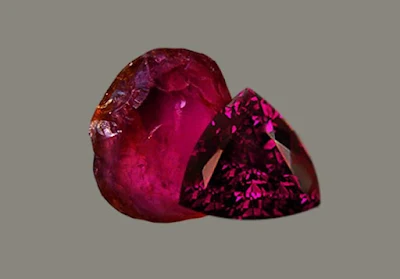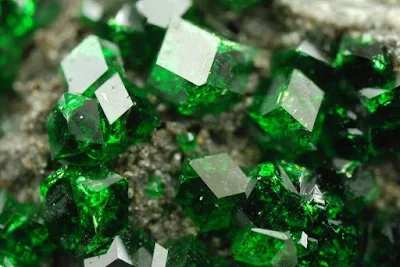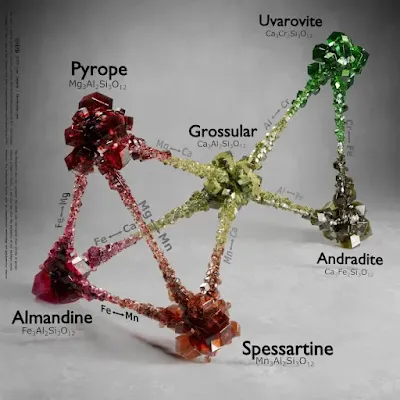Garnet: Colors and Types of Garnet
Garnet is a group of silicate minerals: Garnet is most commonly known for its deep red hues, but that's just the tip of the iceberg! They come in a surprising variety of colors, including orange, yellow, green, pink, purple, brown, black, and even colorless. The specific color of a garnet depends on the presence of trace elements within its crystal structure.
Garnet is not a single mineral, but garnet describes a group of several closely related minerals. All species of garnets possess similar physical properties and crystal forms, but differ in chemical composition and colors.
Garnets are formed under high pressure and temperature conditions, and are often found in metamorphic and igneous rocks. They are also found in some sedimentary rocks, such as sandstones and limestones.
Because the chemical composition of garnet varies, the atomic bonds in some species are stronger than in others. As a result, this mineral group shows a range of hardness on the Mohs scale of about 6.5 to 7.5.
Garnet Classification
Garnets are nesosilicates having the general formula X3Y2(SiO4)3. The X site is usually occupied by divalent cations (Ca, Mg, Fe, Mn)2+ and the Y site by trivalent cations (Al, Fe, Cr)3+ in an octahedral/tetrahedral framework with [SiO4]4− occupying the tetrahedra.
Garnetsare classified into two main groups based on their chemical composition. Whether the Y or the X component in the chemical composition of the species is constant, we can divide the members of the garnet family into two groups:
- PyrAlSpites Aluminum Garnets (Pyrope, Almandine, Spessartite) Aluminium in Y site
- UGrAndites Calcium Garnets (Uvarovite, Grossular, Andradite) Calcium in X site
Each member of these two groups has an "ideal" chemical makeup.
- Pyrope (magnesium aluminum silicate)
- Almandine (iron aluminum silicate)
- Spessartite (manganese aluminum silicate)
- Uvarovite (calcium chromium silicate)
- Grossular (calcium aluminum silicate)
- Andradite (calcium iron silicate)
In the PyrAlSpites list above, the first element mentioned changes from member to member. However, in nature one will never find a pyrope garnet with such a pure chemical makeup. Instead, during growth other elements -- present in the melt from which the pyrope grew -- were mixed in.
When iron (as seen in almandine, above) is mixed in during the growth of a pyrope garnet, one would get a magnesium-iron aluminum silicate. Part of the magnesium content in the pyrope was replaced by iron.
It is the amount of magnesium/iron content that defines the distinguishing line between pyrope and almandine. When there is an abundance of magnesium in the chemical makeup, it is a pyrope. When iron is dominant, it is almandine garnet.
When the mix is somewhere in between, we name it pyrope-almandine garnet. (These mixtures may have some exotic names, such as rhodolite, that are not of importance here). It should be noted that the boundaries where it is a pyrope or where it is an almandine is under heavy debate.
Garnet Types and Varieties
Almandine
 |
| Almandine Garnet with Muscovite From Gilgit, Gilgit District, Northern Areas, Pakistan. Photo: mardani Fine Minerals |
Almandine is the most common Garnet. The almandine crystal formula is: Fe₃Al₂Si₃O₁₂. Almandine, like other garnets, forms rounded crystals with 12 rhombic or 24 trapezoidal faces or combinations of these and some other forms. This crystal habit is classic for the garnet minerals.
Almandine is the iron aluminum garnet. Magnesium can substitute for the iron and become more like pyrope, the magnesium aluminum garnet. Pure almandine and pure pyrope are rare in nature and most specimens are a percentage of the two. Almandine range in color from Dark red to black. t is frequently cut with a convex face, or en cabochon, and is then known as carbuncle.
Pyrope
 |
| Rough Pyrope |
Pyrope is a magnesium aluminum silicate, known for its beautiful red hues. Its name comes from the Greek words "pyros" (fire) and "ops" (eye), reflecting its fiery red color that resembles a burning eye.
Pyrope is the only member of the garnet family to always display red colouration in natural samples. Pyrope is especially noted for its transparency and frequent lack of flaws or inclusions. The composition of pure pyrope is Mg₃Al₂Si₃O₁₂, although typically other elements are present in at least minor proportions—these other elements include Ca, Cr, Fe and Mn. The origin of most pyrope is in ultramafic rocks, typically peridotite from the Earth's mantle: these mantle-derived peridotites can be attributed both to igneous and metamorphic processes.
Varieties of Pyrop:
Rhodolite
 |
| Rough and cut Rhodolite |
Rhodolite is not a single mineral but rather a hybrid of two other garnets: almandine and pyrope. This unique blend gives rise to its stunning pinkish-purple to reddish-purple color, often with subtle hints of blue or green.
The name and color come from the flower of the rhodondendron. It is often regarded as a variety of Pyrope.
Malaya
 |
| Malaia garnet color change. |
Malaya garnet (also spelled Malaia garnet) is a reddish-orange to pinkish-orange variety of garnet. It is primarily a mixture of pyrope and spessartine, often with minor amounts of almandine. This unique compositional blend is responsible for its distinctive color range, which can include shades of peach, pink, and orange.
Malaya garnets were first discovered in the 1970s in the Umba Valley, Kenya and Tanzania, often as a byproduct during the mining of rhodolite garnet.
The name "Malaia" comes from the Swahili word malaya, which colloquially means “outcast” or “prostitute,” a reference by local miners to this unusual garnet that did not fit into known gem categories at the time.
Some Malaya garnets may display chroma or color shift, particularly under different lighting conditions (e.g., daylight vs. incandescent light), but they do not exhibit opalescent play-of-color like opals.
Spessartine
 |
| Rough and cut Spessartite Garnet. Photo: Gran Gem (@grangemltd) |
Spessartite, sometimes spelled "spessartine,". Spessartite is an orange to red form of the gemstone Garnet. Spessartite is a nesosilicate, manganese aluminium garnet species, with the chemical formula Mn²⁺₃Al₂(SiO₄)₃.
Spessartite is known for its vibrant orange and pink hues, ranging from a light, peachy pink to a deep, reddish orange. It can even have hints of yellow or brown depending on the specific composition of the stone.
While not as rare as some other garnets like Tsavorite, spessartite is still considered relatively uncommon. It primarily occurs in metamorphic rocks and pegmatites, found in locations like Namibia, Madagascar, and Sri Lanka.
While not as rare as some other garnets like Tsavorite, spessartite is still considered relatively uncommon. It primarily occurs in metamorphic rocks and pegmatites, found in locations like Namibia, Madagascar, and Sri Lanka.
Spessartite can be mistaken for other orange gemstones like hessonite garnet and citrine. However, spessartite has a higher refractive index, meaning it sparkles more brilliantly under light.
Andradit
 |
| Demantoid Andradite Garnet on matrix. Photo: Ali (@deygallery) |
Andradite is a calcium-iron garnet, with the chemical formula Ca₃Fe₂Si₃O₁₂. It's the most common garnet mineral within the nesosilicate category, but its composition and appearance can vary greatly.
Andradite's color palette is quite diverse, ranging from deep black and brown to vibrant green and yellow, and even a fiery red.
The name "andradite" comes from José Bonifácio de Andrada, a Brazilian mineralogist who first described the mineral in 1868.
Andradite occurs in skarns developed in contact metamorphosed impure limestones or calcic igneous rocks; in chlorite schists and serpentinites and in alkalic igneous rocks (typically titaniferous).
Andradite Varieties
 |
| Andradite Varieties, Melanite, Demantoid, Topazolite |
Melanite
Melanite is a variety of andradite garnet, specifically the one where iron is replaced by titanium. This substitution gives it its distinctive deep black color, often with a hint of green or brown depending on the specific stone.
The name "melanite" comes from the Greek word "melas," meaning "black," aptly reflecting its color.
Demantoid
Demantoid is a variety of Andradite garnet, known for its intense emerald green color and exceptional brilliance. It's often called the "Cape emerald" due to its historical presence in South Africa. The name "demantoid" itself comes from the French word "diamant," meaning "diamond," highlighting its sparkle that even surpasses diamonds in some cases.
Demantoid is one of the rarest garnet varieties, found in only a few locations worldwide, primarily in Namibia, Russia, and Madagascar.
Demantoid is sometimes used as a birthstone for May, alongside emerald.
Some demantoid garnets exhibit a phenomenon called "horsetail inclusions", which are needle-like inclusions that resemble a horse's tail.
Topazolite
Topazolite garnet is a variety of andradite garnet characterized by its yellowish-orange to honey-yellow color. This vibrant hue comes from the presence of iron and titanium within the stone's chemical composition.
Topazolite's color palette can range from a pale, almost lemon-yellow to a richer, honey-like orange. The intensity of the hue depends on the iron content, with higher iron levels resulting in deeper orange tones.
While not as rare as some other garnets like tsavorite, topazolite is still considered relatively uncommon. It's found primarily in Mexico, Namibia, and Madagascar.
Topazolites can exhibit a phenomenon called chatoyancy, a silky sheen that moves across the stone when light hits it.
Grossular
 |
| Hydrogrossular from Jeffrey Mine Asbestos, Quebec Canada |
Grossular is the most varicolored of the Garnets.
Grossular is a calcium-aluminum silicate mineral, one of the main types of garnets. Its chemical formula is Ca₃Al₂(SiO₄)₃, but some calcium can be replaced by iron, and aluminum by ferric iron, leading to its diverse color variations.
Pure Grossular is colorless; the wide range of colors in this Garnet is caused by various impurities. Some Grossular types have their own unique variety or trade names, and are only called by these names in the gemstone market. The orange-brown Hessonite and deep green Tsavorite varieties are the best known varieties.
Grossular itself is a relatively common garnet, but high-quality stones with intense colors and exceptional clarity can be moderately rare and valuable.
The name "grossular" comes from the Latin word "grossularia," meaning "gooseberry," referring to its green variety.
Varieties of Grossular
Hessonite
Hessonite is a gem-quality variety of grossular garnet, characterized by its rich honey-orange to reddish-orange color. This warm hue is due to the presence of iron and manganese within the stone's chemical composition. The name "hessonite" likely comes from the Greek word "hesson," meaning "inferior," possibly referencing its similarity to other, more valuable orange gemstones like topaz.
Hydrogrossular
Hydrogrossular is a variety of grossular garnet that incorporates water molecules within its crystal structure. This unique characteristic gives it several distinct properties compared to other garnets. The name "hydrogrossular" combines "hydro" for water and "grossular" for the garnet variety, aptly reflecting its composition.
Hydrogrossular can be found in a range of colors, including colorless (leucogarnet), yellow, green, orange, and even brown. The presence of different impurities and trace elements influences its hue.
Some varieties exhibit a unique "watery" appearance due to the presence of water molecules.
 |
| Tsavorite garnets on graphite matrix From Merelani Mine, Arusha, Tanzania. Credit: Anton Watzl |
Chrome grossular
Chrome grossular is a variety of grossular garnet where chromium replaces some of the iron in its chemical composition. This substitution gives rise to its stunning emerald green color with exceptional brilliance.
Tsavorite
Tsavorite is a variety of grossular garnet, known for its intense emerald green color and exceptional brilliance. It is coloured by chromium and/or vanadium. The distinction between a 'regular' green grossular and tsavorite is commonly thought to be a function of saturation and tone.
Tsavorite is a relatively rare gemstone, found primarily in Kenya and Tanzania.
Tsavorite was first discovered in 1967 in Tanzania by Dr. Campbell Bridges, who named it after the Tsavo National Park.
Mali
Mali garnet, also known as "grandite," is a rare and intriguing variety of garnet found in Mali, West Africa. It is a mixture of grossular and andradite. Mali garnets can be found in a variety of colors, including yellow, green, orange, and brown.
Uvarovite
 |
| Green uvarovite crystals on chromite matrix from Ural, Russia. Photo: R. Tanaka |
Uvarovite is a chromium-bearing garnet, with chromium replacing iron in its chemical composition the formula Ca₃Cr₂(SiO₄)₃. Uvarovite's emerald green color can range from a light, almost grassy hue to a deep, vibrant shade that rivals the finest emeralds.
Uvarovite is one of the rarest garnet varieties, found in only a few locations worldwide, primarily in Russia, Finland, and the Ural Mountains.
The name "uvarovite" is a tribute to Count Sergei Semenovitch Uvarov, a Russian statesman and mineral collector who first identified the gem in 1832.
Knorringite
Knorringite is a magnesium-chromium garnet, belonging to the pyrope-grossular garnet series. This means it occupies a specific position within the garnet spectrum, containing both magnesium and chromium as its primary coloring agents. Its chemical formula is Mg₃Cr₂(SiO₄)₃, highlighting the key elements contributing to its characteristics.
Knorringite exhibits a range of colors, primarily green and blue, with varying shades and intensities depending on the chromium content.
Knorringite was first discovered in 1968 in the Kao kimberlite pipe in Lesotho and named after Oleg Von Knorring, a professor of mineralogy at the University of Leeds.
See also:
How Does a Trapiche Emerald Form?
How Does Opal Get Its Color?







%20(1).webp)



